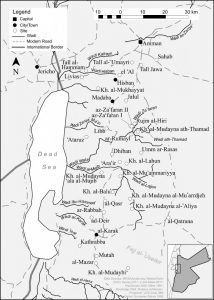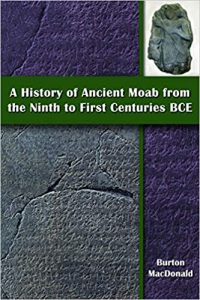Moab está situado na Transjordânia, entre os vales do Zered e do Arnon, porém levava frequentemente sua fronteira ao norte do Arnon. Seu território principal está situado em um planalto de 1200 metros de altitude.
As cidades do ano 3000 a.C. foram destruídas e abandonadas. Aí por volta de 1300 a.C. o país foi novamente ocupado por semitas nômades e pastores.
Sua capital era Kir-hareseth (Kir, Kir-heres), a moderna Kerak. Outras cidades: Aroer, Dibon, Medeba e Heshbon. Cerca de oito km a oeste de Medeba está o monte Nebo ou Pisgah, segundo textos bíblicos.
No século I d.C., a sudoeste do monte Nebo estava a fortaleza de Maqueronte, onde Herodes Antipas mandou matar João Batista, segundo relatos dos evangelhos. Moab e Israel eram rivais. Antes de Israel adotar a monarquia como forma de governo, Moab já o fizera. Seu deus principal era Kemosh. Sua língua se assemelha bastante ao hebraico.
Um artigo
Ancient Moab: from the Ninth to First Centuries BCE – By Burton MacDonald
The Bible and Interpretation – June 2020
Os antigos moabitas eram constituídos por vários grupos. Eles eram provavelmente descendentes, pelo menos em parte, dos Shûtu/Sutu e/ou Shasu. Os mais antigos aparecem nas Cartas de Tell el-Amarna, datadas do século XIV a.C., como “sem lei” e “tramando rebelião”. Às vezes, porém, os egípcios os usavam como mercenários. Os textos os retratam como pastores na região do sul da Jordânia (possivelmente mais ao norte e até mesmo na Cisjordânia) a quem os egípcios permitiram levar seus rebanhos para pastar no leste do delta do Nilo. Os egípcios tentaram sedentarizá-los, mas aparentemente não tiveram sucesso. O termo acádio Shûtu/Sutu pode ser uma contrapartida do termo egípcio Shasu, que significa “andar a pé”, “vagar”. O termo Shasu aparece nos textos egípcios da Décima Nona Dinastia (de 1292 a 1189 a.C.). Refere-se a nômades e seminômades que vivem em tendas e pastoreiam rebanhos na região do sul da Transjordânia. Eles não constituíam um grupo étnico. Em vez disso, são retratados como pastores que os egípcios tinham que manter sob controle para proteger suas distantes fronteiras orientais. Em relação ao Shasu, W. G. Dever, Beyond the Texts: An Archaeological Portrait of Ancient Israel and Judah. Atlanta: SBL, 2017, p. 102, menciona a frase “o Shasu de yah“. Essa poderia ser a mais antiga menção a Iahweh.
A number of groups constituted ancient Moab. They were most likely descendants, at least in part, of the Shûtu/Sutu and/or Shasu. The former appear in the Amarna Letters, dated to the 14th century BCE, as “lawless” and “plotting rebellion.” Sometimes, however, the Egyptians co-opted them as mercenaries. The texts portray them as pastoralists in the region of southern Jordan (possibly farther north and even in Cisjordan) whom the Egyptians allowed to graze their flocks in the eastern Nile Delta. The Egyptians attempted to sedentarize them, but apparently were unsuccessful. The Akkadian term Shûtu/Sutu may be a counterpart of the Egyptian term Shasu, meaning “to move on foot,” “to wander.” The term Shasu appears in Nineteenth Dynasty (lasting from 1292 to 1189 BCE) Egyptian texts. It refers to nomadic and semi-nomadic people, living in tents and herding flocks, in the region of southern Transjordan. They did not constitute an ethnic group. Rather, they are portrayed as pastoralists whom the Egyptians had to keep in check in order to guard their remote eastern borders. Relative to the Shasu, Dever (2017: 102) mentions the phrase “the Shasu of yah.”  Such could be the earliest mention of Yahweh.
Such could be the earliest mention of Yahweh.
Um livro
MACDONALD, B. A History of Ancient Moab from the Ninth to First Centuries BCE. Atlanta: SBL Press, 2020, 304 p. – ISBN 9781628372687
Este livro sobre Moab apresenta dados arqueológicos, epigráficos, bíblicos e pós-bíblicos para construir um panorama da história dos moabitas que habitavam na Transjordânia. A análise das descobertas arqueológicas mostra que, embora seu território não fosse rico em recursos, sua aliança com os assírios os fez prosperar.
A History of Ancient Moab from the Ninth to First Centuries BCE incorporates archaeological, epigraphic, biblical, and postbiblical evidence to construct a picture of Moabite history beginning with their origin in the Transjordan through their emergence on the international stage. Analysis of inscriptional and archaeological discoveries shows that, although their territory was not rich in resources, their service to the Assyrian Empire made them prosperous.
